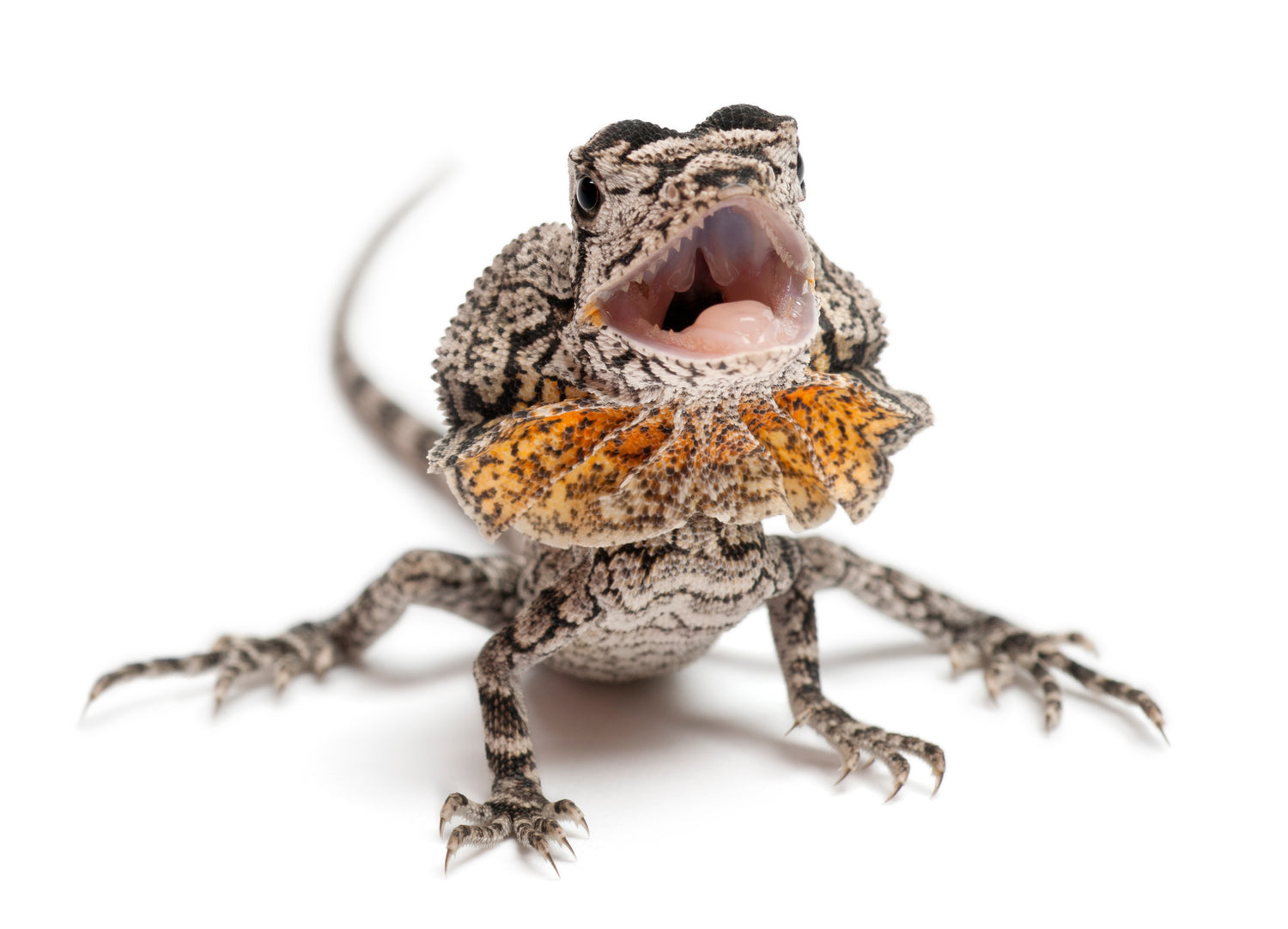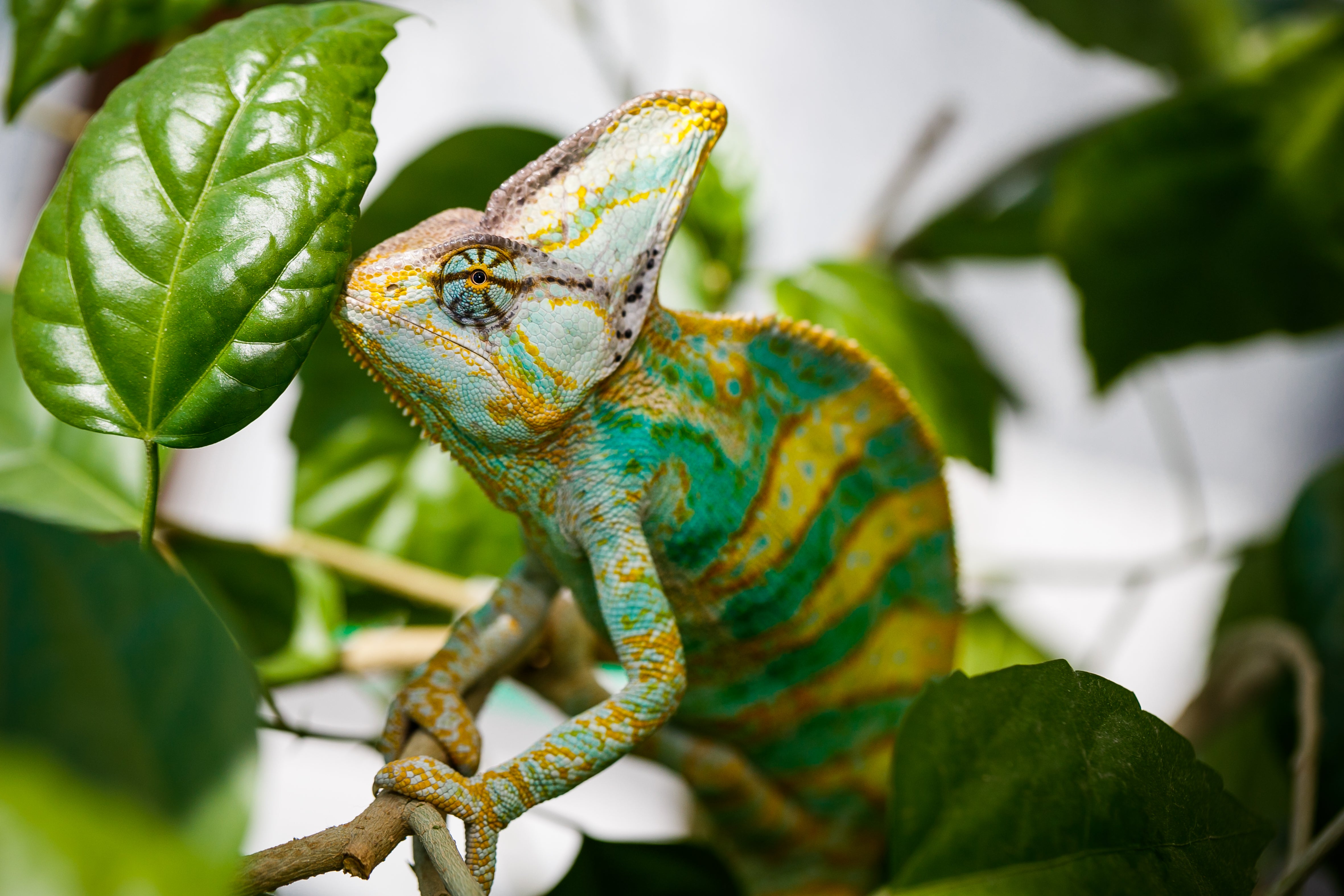Frilled lizards (Chlamydosaurus kingii) are 2-3’ long, diurnal, arboreal lizards native southern New Guinea and certain areas of northern Australia. They typically prefer subhumid to semi-arid habitats such as grassy woodlands and dry sclerophyll forests.
Frilled lizards are primarily brown, black, and gray, although in some localities, they may have red, orange, or yellow coloring as well. Color and pattern typically varies by locality since these features are used for camouflage. Frilled lizards get their common name from the large ruff around the neck, which can expand to a circular cowl when they are upset or on the defensive. Females are much smaller than males, and New Guinea individuals are generally much smaller than Australian specimens.
Due to their size, low handleability, and sensitivity to poor husbandry, frilled lizards are advanced-level pet reptiles. With good care, they can live up to about 10 years.
How much space do frilled lizards need?
A single frilled lizard should be housed in no smaller than a 5’L x 2.5’W x 4’H enclosure in order to provide adequate space for climbing and thermoregulating. If at all possible, larger is strongly recommended. This size of enclosure is not typically available for purchase, so you will need to order one custom-made or build your own.
Cohabitation (keeping multiple frilled lizards in the same enclosure) is not recommended.
Do frilled lizards need UVB?
Frilled lizards are diurnal, which means that they are most active during the day. This also means that UVB is required for them to thrive in captivity. Aside from helping provide a day/night cycle and providing an infinite supply of vitamin D, UVB is also good for the lizard’s overall health.
You will need a high-quality UVB lamp as part of the lizard’s enclosure. Here are the best UVB bulbs for frilled lizards housed in a 5’L x 2.5’W x 4’H enclosure:
- Arcadia Desert 6%, 34”
- Zoo Med Reptisun T5 HO 5.0, 34”
The UVB should be mounted inside the enclosure, with the basking branch placed so the lizard’s back is 11-12” below the lamp. The UVB bulb should be housed in a reflective fixture such as Arcadia or Vivarium Electronics, and placed on the basking side along with the heat lamp. Make sure that the fixture your UVB bulb is housed in does not have a clear plastic bulb cover, as plastic and glass block UVB wavelengths.
Since frilled lizards are active during the day, it’s beneficial to provide an additional daylight-spectrum lamp to make sure the enclosure is brightly illuminated. This is extra important since you will be using such a large enclosure. Use 3-4’ of strong 6500K LED or T5 HO fluorescent plant grow lights for best results.
Lights should be on for 13 hours/day during summer and 11 hours/day during winter. Simulating seasonal changes in day length encourages more natural hormonal cycling, and is likely to encourage better health in your pet.
What basking temperatures do frilled lizards need?
Frilled lizards need a basking surface temperature of 115°F and an average temperature everywhere else in the enclosure between 85-90°F. Nighttime temps can drop down to 75-80°F. The basking surface itself should be a thick, sturdy wood branch placed near the top of the enclosure per the specifications listed previously.
Provide heat for your lizard by imitating the sun with a cluster of halogen heat lamps placed on one side of the enclosure. You will need enough lamps to evenly heat an area at least the size of the lizard’s body. Do not use heat mats, red bulbs, or blue bulbs, as these are not as effective.
If you need help maintaining nighttime temps of at least 75°F, use a radiant heat panel connected to a thermostat to keep the air comfortably warm inside the enclosure.
What humidity levels do frilled lizards need?
Frilled lizards thrive during the rainy season in their natural habitat, so it’s a good idea to maintain average humidity levels around 70%. Juveniles should be misted 3x/day with a pressure sprayer to stay hydrated, but adults can be misted only 1-2x/day. Never spray your lizard directly in the face!
Using a humidifier connected to a humidistat is helpful for maintaining high humidity, especially at night.
What substrate is good for frilled lizards?
Although frilled lizards spend a lot of time off the ground, using substrate in the enclosure will cover the floor and help provide a cushion in the unlikely event that the lizard falls from its perch. It also helps maintain humidity!
We recommend the following substrates for frilled lizards:
Substrate should be at least 2” deep and completely replaced every 3-4 months. Remove poop and urates daily, along with any contaminated substrate.
What décor can you use in a frilled lizard terrarium?
At bare minimum, your frilled lizard will need a good climbing branch, but only offering one branch and no hiding opportunities is likely to result in a stressed, unhappy frilled lizard. One of the best ways you can help your pet be happy in its enclosure is to fill it with things for the lizard to use and interact with.
Here are some ideas for decorating and enriching your pet’s enclosure:
- additional climbing branches
- raised platforms
- hollow logs
- hiding places
- live or artificial foliage
Although frilled lizards aren’t particularly heavy, all climbing branches should still be securely anchored into the walls/floor of the enclosure to prevent collapse.
What do frilled lizards eat?
Frilled lizards are primarily carnivorous, which means that they need to eat animal-based foods to get the nutrition that they need. Specifically speaking, frilled lizards prefer to eat insects and small vertebrates. They may or may not eat a significant amount of vegetation, but experienced keepers recommend providing it just in case.
Offer as many insects per meal as your frilled lizard will eat in 5-10 minutes. Juveniles should be fed up to 3x/day. Adults should be fed only 1x/day or every other day, depending on meal size and body condition. Fresh vegetables should be offered daily for your lizard to pick from as desired.
Feeder insect options: crickets, discoid roaches, dubia roaches, earthworms, grasshoppers, hornworms, silkworms, mealworms, superworms, snails (captive-bred only)
Vegetable options: collard greens, cactus pads, spring mix, arugula, kale, alfalfa, bok choy, carrot greens, spinach, dandelion greens/flowers, hibiscus greens/flowers
Fruits such as bananas, berries, grapes, melons, papaya, and mango make good treats.
Small vertebrates such as young rodents and feeder lizards can also be offered as treats.
Supplements
You will also need calcium and vitamin supplements to prevent your lizard from developing a deficiency. We recommend Repashy Calcium Plus LoD, lightly dusted on all insects.
Water
Although your frilled lizard will get most of its drinking water from daily mistings, it’s a good idea to also provide a large wall-mounted water dish. Change the water daily and scrub the bowl with a reptile-safe disinfectant weekly, or whenever it becomes soiled.
Do frilled lizards like to be handled?
Truthfully, few reptiles actually “like” to be handled, and frilled lizards in particular are unlikely to appreciate human interaction. The key to building a trusting relationship with your pet is to provide as many positive interactions as possible. Offering food from feeding tweezers works well as an initial bribe, and it’s best to get the lizard to come to you rather than simply grabbing it.
*This care sheet contains only very basic information. Although it’s a good introduction, please do further research with high-quality sources to obtain additional information on caring for this species.




Leave a comment
This site is protected by hCaptcha and the hCaptcha Privacy Policy and Terms of Service apply.